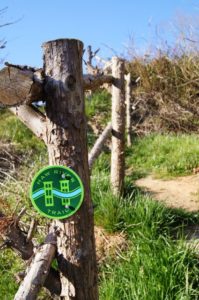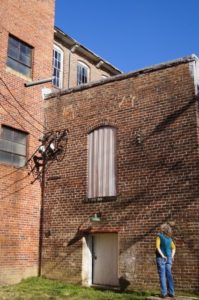
I thought we had lost the trail but in fact we were smack dab on course. The Haw River Trail was intended, it turns out to meander through the Glencoe neighborhood of restored mill homes.
Yet another attraction of this 70-mile work-in-progress that runs from Haw River State Park above Greensboro to its namesake river’s exciting conclusion — especially after a good rain — in Jordan Lake. In addition to showing off the natural beauty along — and in — the Haw — the trail is intended to showcase, and in the process help preserve, the remarkable human history that has evolved along the river. (Check out yesterday’s 90 Second Escape along the Haw for a video perspective.)
The Haw River Trail (which includes a paddling alternative) is a decade-old effort that was galvanized in 2006 when 10 government agencies signed a memorandum of understanding basically indicating they would work together to preserve the Haw. At the same time, Burlington and Graham partnered with Alamance County, Elon University, Preservation North Carolina and the Z. Smith Reynolds Foundation to fund a full-time position to coordinate conservation and trail efforts on the Upper Haw River. The Mountains-to-Sea-Trail piggybacks on the Haw River Trail from Haw River State Park through Alamance County, before heading east to Hillsborough.

So far, those efforts have resulted, in part, in 10 miles of on-the-ground trail, including the 4.3 miles we explored Sunday afternoon. (In addition, there’s trail in Haw River State Park, Swepsonville River Park, and along the lower Haw in the Lower Haw River State Natural Area, from Bynum downstream to Jordan Lake.) The trail runs downstream from Indian Valley Golf Course, through the old mill town of Glencoe, where Preservation North Carolina launched an effort in 1999 to restore the 1880s community. The Glencoe detour, up Back Street, down Front Street, satisfies both the historian (home restorations must adhere to period standards) and the real estate voyeur (generous front windows from back in the day offer a peak into what the Joneses have been up to). The trail also swings by the Textile Heritage Museum, which is worth a visit (if you’re there on a Saturday or Sunday between 1 and 4 p.m.). And while you can’t explore inside, the old Glencoe Mill and Carolina Mill a mile downstream, offer a fascinating outside look into the history of an industry that dominated life along the Haw from 1832 deep into the 20th century.
Haw River Land Trail
View Haw River Land Trail in a larger map
Elsewhere, the trail here at Great Bend Park spends most of its time snuggled up next to the Haw, an unusually rocky river for the Piedmont. In spots, the river is lake-placid. But you needn’t go far before those rocky drops make for a chatty companion.
It’s that mix of flat and white water that makes the Haw popular with paddlers. In Alamance County alone there are a dozen access points for paddlers. (Downstream in Chatham County there are at least three more.) Most offer access to whitewater, the intensity of which depends on recent rainfall. Three access points are located at dams, offering flatwater upstream and white down. Most of the river is considered suitable for beginners (though note that canoeists and kayakers putting in at Glencoe and Town & Country should have intermediate level skills).
Find directions and additional details about each put in on the paddle trail map below:
Haw River Paddle Trail
View Haw River Paddle Trail in a larger map

Both of the above maps should help with planning a trip — by land or by water — on the Haw. You’ll find additional helpful information at the Haw River Trail Web site.
* * *
